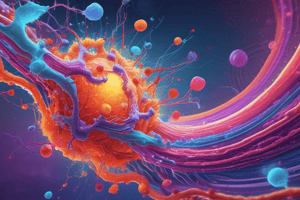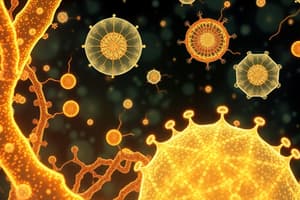Podcast
Questions and Answers
Which of these is a receptor molecule?
Which of these is a receptor molecule?
- Option 4
- Option 3
- Option 2 (correct)
- Option 1
A signal transduction pathway is initiated when a _____ binds to a receptor.
A signal transduction pathway is initiated when a _____ binds to a receptor.
signal molecule
Which of these is a signal molecule?
Which of these is a signal molecule?
- Option 1 (correct)
- Option 3
- Option 2
- Option 4
A signal molecule is also known as a(n) ____.
A signal molecule is also known as a(n) ____.
Which of these is the second of the three stages of cell signaling?
Which of these is the second of the three stages of cell signaling?
Complete the flowchart describing the interaction of cortisol with intracellular receptors.
Complete the flowchart describing the interaction of cortisol with intracellular receptors.
What do G protein-coupled receptors do?
What do G protein-coupled receptors do?
What catalyzes the transfer of a phosphate group to the receptor in receptor tyrosine kinases?
What catalyzes the transfer of a phosphate group to the receptor in receptor tyrosine kinases?
What binds the signaling molecules to both types of receptors?
What binds the signaling molecules to both types of receptors?
Binding of the signaling molecule allows ions to flow through a channel in the receptor.
Binding of the signaling molecule allows ions to flow through a channel in the receptor.
Which statements are true about the binding of histamine to the histamine H1 receptor?
Which statements are true about the binding of histamine to the histamine H1 receptor?
Which of these acts as a second messenger?
Which of these acts as a second messenger?
Which of these is responsible for initiating a signal transduction pathway?
Which of these is responsible for initiating a signal transduction pathway?
What role does a transcription factor play in a signal transduction pathway?
What role does a transcription factor play in a signal transduction pathway?
Which of these is a membrane receptor?
Which of these is a membrane receptor?
Calcium ions that act as second messengers are stored in ____.
Calcium ions that act as second messengers are stored in ____.
_____ catalyzes the production of _____, which then opens an ion channel that releases _____ into the cell's cytoplasm.
_____ catalyzes the production of _____, which then opens an ion channel that releases _____ into the cell's cytoplasm.
A protein kinase activating many other protein kinases is an example of ____.
A protein kinase activating many other protein kinases is an example of ____.
What is apoptosis?
What is apoptosis?
What hypothesis was being tested with the ΔFus3 strain?
What hypothesis was being tested with the ΔFus3 strain?
What hypothesis was being tested with the Δformin strain?
What hypothesis was being tested with the Δformin strain?
What is the purpose of including wild-type yeast cells in the experiment?
What is the purpose of including wild-type yeast cells in the experiment?
If the hypothesis that Fus3 kinase is required for the signal transduction pathway leading to shmoo formation is correct, what result should be observed in the ΔFus3 strain?
If the hypothesis that Fus3 kinase is required for the signal transduction pathway leading to shmoo formation is correct, what result should be observed in the ΔFus3 strain?
If the hypothesis that formin is required for the signal transduction pathway leading to shmoo formation is correct, what result should be observed in the Δformin strain?
If the hypothesis that formin is required for the signal transduction pathway leading to shmoo formation is correct, what result should be observed in the Δformin strain?
What would you predict would happen if the yeast had a mutation that prevented the G protein from binding GTP?
What would you predict would happen if the yeast had a mutation that prevented the G protein from binding GTP?
Match the following processes with their descriptions:
Match the following processes with their descriptions:
Study Notes
Cell Signaling Overview
- Receptor molecules, such as G protein-coupled receptors and receptor tyrosine kinases, initiate cell signaling pathways when a signal molecule (ligand) binds to them.
- Signal transduction pathways consist of three main stages: reception, transduction, and response.
Key Components of Signal Transduction
- Signal Molecules (Ligands): Chemicals that bind to receptors to initiate signaling, e.g., cortisol.
- Transduction: The process where the signal is converted into a response, often involving secondary messengers like cyclic AMP and calcium ions.
- Receptors:
- G protein-coupled receptors interact directly with G proteins.
- Receptor tyrosine kinases transfer phosphate groups upon activation.
- Binding sites for signaling molecules are located extracellularly.
Cortisol Mechanism
- Cortisol passes through the plasma membrane, forms a complex with intracellular receptors, and acts as a transcription factor in the nucleus to regulate gene expression.
Histamine Signaling
- Histamine activates the H1 receptor (a G protein-coupled receptor), leading to conformational changes and G protein activation.
- Phospholipase C cleaves PIP2 to generate second messengers, DAG and IP3; IP3 triggers calcium ion release from the endoplasmic reticulum, increasing cytosolic calcium concentrations.
Apoptosis
- Apoptosis is a controlled process of programmed cell death, crucial for maintaining cellular homeostasis.
Experimental Design in Yeast Studies
- The ΔFus3 and Δformin yeast strains were tested to evaluate the role of Fus3 kinase and formin in the signal transduction pathway leading to shmoo formation.
- Wild-type strains serve as controls to compare normal and mutant responses.
- The outcome of forming shmoos in response to mating factors indicates successful signaling pathways.
Key Hypotheses and Predictions
- If formin and Fus3 kinase are required for shmoo formation, mutations that prevent their function (ΔFus3 and Δformin strains) should result in the absence of shmoo formation.
- Predictions support that lack of G protein binding to GTP results in no shmoo formation in yeast.
Why Different Responses Occur
- Variability in response to histamine is attributed to:
- Different relay molecules present in cells.
- Specific enzymes activated by G proteins.
- Types of second messengers involved.
- Cell types where histamine receptors are located.
Shmoo Formation Mechanism
- Shmoo projections emerge on the side of yeast cells that bound mating factors due to localized activation of formin by G protein-coupled receptor signaling, resulting in polarized growth responses.
Studying That Suits You
Use AI to generate personalized quizzes and flashcards to suit your learning preferences.
Description
Test your knowledge of key concepts from Chapter 11 of Mastering Biology. This quiz covers important terms such as receptor molecules and signal transduction pathways, which are crucial for understanding cellular communication. Perfect for students looking to reinforce their learning in this subject area.




